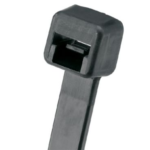In the realm of cable management, learning what is UV resistant cable tie material is crucial for ensuring the longevity and reliability of your installations. UV cable tie material refers to the composition of cable ties specifically engineered to withstand prolonged exposure to ultraviolet (UV) radiation without degradation or deterioration. This is particularly essential for outdoor applications where cable ties are exposed to sunlight, which can break down conventional materials over time.
What Makes UV Cable Tie Material Special?
UV resistant cable tie material is typically made from high-quality polymers infused with additives that provide protection against UV radiation. These additives act as stabilizers, shielding the cable ties from the harmful effects of sunlight, such as embrittlement, discoloration, and loss of tensile strength. Unlike standard cable tie materials, which may become brittle and prone to snapping when exposed to UV rays, UV resistant variants maintain their structural integrity, ensuring secure and reliable cable management solutions, even in challenging environments.
One of the key advantages of UV resistant tie material is its ability to withstand prolonged exposure to outdoor elements, including sunlight, rain, and extreme temperatures, without compromising performance. This makes it ideal for a wide range of outdoor applications, such as securing cables and wires in solar installations, telecommunications infrastructure, landscaping projects, and marine environments. By investing in UV cable tie material, users can avoid the hassle and expense of frequent replacements, reducing maintenance costs and ensuring long-term reliability.
Choosing the Right UV Resistant Cable Tie Material
When selecting UV resistant cable tie material for your specific application, it's essential to consider factors such as the duration and intensity of UV exposure, environmental conditions, and the type of cables being secured. Different materials offer varying levels of UV resistance, so it's crucial to choose one that meets the requirements of your project. Additionally, opting for cable ties with UV resistant certifications, such as UL (Underwriters Laboratories) 62275, provides assurance of quality and performance.
Best Uses and Practices for UV Cable Tie Material
1. Outdoor Installations:
UV resistant cable tie material is best suited for outdoor installations where cable ties are exposed to direct sunlight. These include solar panel installations, outdoor lighting setups, and landscaping projects. By using UV resistant cable ties, you can ensure that your cable management system remains secure and reliable, even in harsh outdoor environments.
2. Marine Applications:
In marine settings, UV resistant cable ties prevent degradation. They maintain integrity of electrical systems on boats, docks, or offshore.
3. Telecommunications Infrastructure:
Telecom infrastructure needs outdoor installations like towers, fiber networks, and cabinets. UV ties secure cables in harsh conditions.
4. Long-Term Projects:
UV cable tie material offers peace of mind in long-term projects. It ensures continuous operation and reduces the need for replacements.
5. Aerospace and Aviation:
UV cable tie material is vital in aerospace for securing wiring. It meets stringent quality standards for durability and longevity.
6. Renewable Energy:
UV cable tie material is crucial for securing cables in renewable energy installations. It maintains peak performance and efficiency.
Things to Avoid When Using UV Resistant Cable Tie Material

1. Overstretching:
Avoid overstretching UV cable ties during installation. It weakens their integrity and reduces effectiveness. Use appropriately sized ties for a snug fit.
2. Excessive Tension:
Refrain from applying excessive tension when tightening UV resistant cable ties. This can lead to premature wear and potential failure over time. Use moderate pressure to secure cables firmly without causing unnecessary strain on the tie material, ensuring long-term reliability.
3. Sharp Edges:
Watch for sharp edges near UV resistant cable ties. They can cause damage and abrasion. Use protective measures like edge protectors.
4. Chemical Exposure:
Avoid exposing UV cable tie material to harsh chemicals. They can degrade its properties. Choose materials designed for chemical exposure.
5. Extreme Temperatures:
UV resistant cable tie material endures various temperatures. Avoid extremes to prevent degradation and maintain structural integrity.
6. Improper Storage:
To maintain the integrity of UV resistant cable tie material, it's essential to store it in a cool, dry environment shielded from direct sunlight and moisture. Exposure to such elements can hasten the aging process and degrade the material prematurely.
Wrapping Up
In conclusion, UV resistant cable tie material plays a vital role in maintaining the integrity and reliability of cable management systems, especially in outdoor environments exposed to sunlight. By understanding the unique properties of UV resistant materials and selecting the right product for your application, you can ensure durable and long-lasting cable installations that withstand the test of time.

